Tariff Of Abominations
Tariff Of Abominations: Easy to understand
The Tariff of Abominations, passed in 1828, was important because it created significant tension between the Northern and Southern states. The North benefited as the tariff protected their growing industries, but the South suffered because it raised the cost of goods they needed and hurt their cotton trade. This highlighted the ongoing issue of economic inequality and regional differences, which are still relevant today as different areas of a country may have conflicting economic interests. Modern examples include debates over taxes and trade policies, where different regions or groups may be affected differently, influencing politics and local economies. People today may experience these effects through changes in the prices of goods or job availability, showing how policies can impact daily life.

Practice Version

Tariff Of Abominations: A very high protective tariff, which hurt both industry and farming. Tariff of Abominations. The Tariff of Abominations was a 1828 U.S. law that imposed high taxes on imports, leading to economic difficulties in the South.